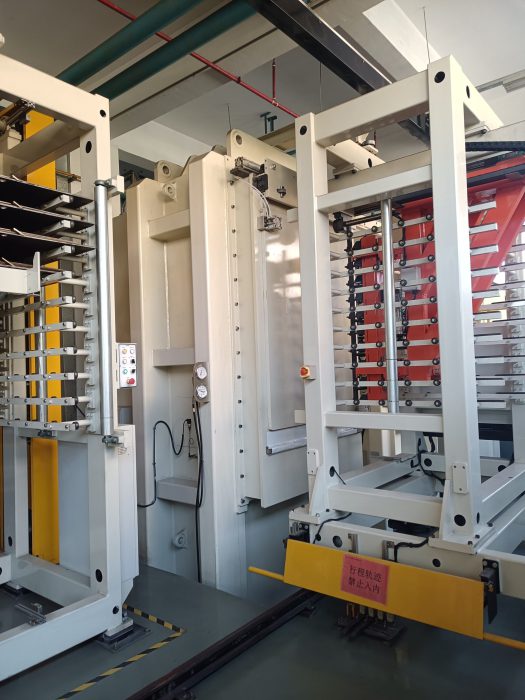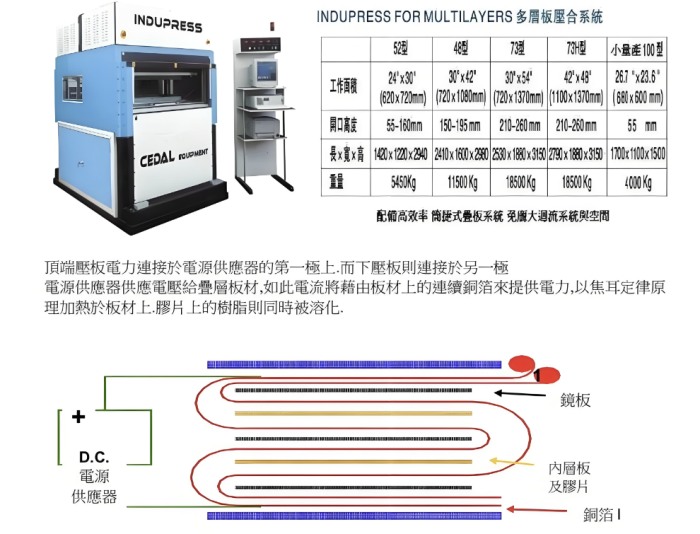 Well-known PCB supplier
Well-known PCB supplier
+86 13603063656

In PCB manufacturing, laminating machines (also known as lamination presses) are one of the most crucial pieces of equipment. Their primary function is to bond different layers of materials, such as copper foil, insulating layers, and core materials, through high temperature and pressure, transforming them into a complete PCB substrate. As electronic components continue to shrink and designs become more complex, the technical requirements for laminating machines have significantly increased. In this article, we will explore the classification, working principles, main parameters, application process, and common defects of laminating machines, as well as how Jerico Multilayer PCB Supplier optimizes the lamination process with advanced equipment to ensure product quality.

Laminating Machines
The development of laminating machines has closely followed the technological progress of PCB manufacturing process. The earliest laminating machines used simple heating systems and mechanical pressure to complete the lamination process manually. As the scale of PCB manufacturing grew and automation became more widespread, laminating machines evolved to include advanced temperature control, precision pressure control, and automatic operation. Particularly in the production of multi-layer PCBs and HDI (High-Density Interconnect) boards, the technical requirements for laminating machines have reached new heights, and precise control of lamination temperature, pressure, and time has become crucial for enhancing PCB quality.
Laminating machines can be classified based on the heating method used. Below are the main types:
Electric heater laminating presses use electric heating elements (typically electric resistance wires) to generate heat, which is then transferred to the laminating plate. This type of machine is simple in design and relatively low-cost, making it suitable for manufacturers with limited budgets.
Advantages:
Low cost: Simple technology leads to lower equipment investment, making it suitable for manufacturers with limited budgets.
Easy operation: The equipment is simple and easy to operate and maintain.
Disadvantages:
High energy consumption: Electric heating is more expensive compared to natural gas or diesel heating.
Uneven temperature distribution: Over time, the electric resistance wires may change resistance, and aging contacts may result in uneven temperature distribution, which is hard to detect and negatively affects the lamination quality.
Slow heating speed: The heating time is relatively long, making it unsuitable for high-efficiency production.
Poor precision: For high-precision PCBs, electric heater laminating presses cannot meet the required precision standards.
Copper foil heating laminating presses use copper foil as the heat source, taking advantage of copper’s high thermal conductivity to evenly distribute heat across the laminating plate.
Advantages:
Uniform heating: Copper’s high thermal conductivity ensures even heat distribution, preventing localized overheating or underheating.
Faster heating speed: Compared to electric heater presses, copper foil presses are more efficient, reducing heating time.
Suitable for high-precision products: Ideal for producing PCBs that require high precision and quality.
Disadvantages:
Higher cost: Copper foil heating systems are more expensive than electric heating systems.
Fire risk: Copper foil heating requires temperature sensors to be installed in the material. Any failure in sensor placement, poor contact, or operator error can lead to abnormal temperature feedback, which, if combined with high power, can quickly lead to fires. Manufacturers using this type of machine have experienced several serious fire incidents.
Equipment strength issues: Due to the use of black-oxide aluminum plates (instead of harder steel plates), increased production volumes often result in excessive pressure during lamination, causing issues like plate edge bubbles, uneven lamination, and deformation.
High maintenance requirements: Copper foil systems need regular inspection and maintenance to ensure their stability.
Remark: This machine is most renowned for its use in Cedal laminating machine, but it does have several significant drawbacks that cannot be overcome. As a result, many PCB manufacturers do not widely adopt it.

Laminating Machines
Thermal oil heating laminating presses use thermal oil as the heat transfer medium, providing stable and even heating at relatively lower temperatures.
Advantages:
Precise temperature control: Thermal oil provides stable temperature control, with individual hot plates maintaining a temperature variation of +/-1°C, and between different plates, a variation of +/-2°C. This minimizes temperature fluctuations and ensures better product quality.
Energy efficiency: Thermal oil can be heated using natural gas or diesel, and the heat can be recovered during the process, saving 30%-50% of energy costs compared to electric heating laminating presses, depending on usage frequency.
High mechanical strength: Thermal oil laminating presses use steel plates and load-bearing decks, which provide high mechanical strength and even pressure, reducing PCB deformation.
Disadvantages:
High equipment cost: Thermal oil heating laminating presses require a high initial investment and maintenance costs, as they require specialized boilers for thermal oil.
Complex operation: Compared to electric and copper foil heating presses, thermal oil presses require more precise operation and management to ensure uniform temperature and accuracy.
Higher energy consumption: Thermal oil heating requires continuous heating, and if the equipment is used infrequently, it can lead to higher energy consumption.
The performance of a laminating machine is influenced by several factors. The main parameters include:
Temperature control: Even and stable temperature is crucial for successful lamination, typically ranging from 150°C to 200°C.
Pressure control: Pressure is another critical parameter, usually between 1.0 MPa and 5.0 MPa, depending on the PCB’s layers, thickness, and material type.
Lamination time: Lamination time generally ranges from 30 minutes to 1 hour, depending on the materials and product requirements.
Temperature gradient: The temperature gradient should be controlled within ±5°C to ensure uniform heat distribution.
The lamination process involves the following key steps:
Material Preparation: The required layers of materials, such as copper foil, insulating layers, and core materials, are prepared, cut, and stacked.
Loading into Laminating Press: The stacked materials are loaded into the laminating press, ensuring proper alignment.
Heating and Pressing: The press heats the materials to the specified temperature and applies the required pressure.
Cooling and Curing: After the lamination process, the materials are cooled to room temperature, ensuring stable bonding between layers.
Unloading and Inspection: After cooling, the laminated boards are unloaded, and visual inspections, dimension checks, and electrical performance tests are conducted to ensure quality.
If not properly controlled, the lamination process can lead to the following common defects:
Layer delamination: Insufficient heating or pressure causes layers to separate.
Bubbles: Trapped air during lamination leads to the formation of bubbles between layers.
Uneven lamination: Inconsistent temperature or pressure causes uneven bonding, resulting in surface unevenness or deformation.
Copper foil detachment: Excessive temperature or pressure can lead to detachment of copper foil from the substrate.
Jerico Multilayer PCB uses advanced thermal oil heating laminating presses and high-precision temperature control systems to ensure that every PCB is laminated under optimal conditions. We strictly control the temperature, pressure, and time throughout the lamination process to ensure that each PCB meets international quality standards, making our equipment especially suitable for complex multi-layer PCBs and HDI boards.
How can I avoid bubble issues during lamination?
Ensure that the surface of the laminating materials is clean and use appropriate venting systems during the lamination process.
What factors should I consider when selecting a laminating machine?
Consider the number of layers, thickness, material, and production requirements when choosing the heating method and machine type.
How do I ensure lamination quality after the process?
Perform dimension checks, electrical performance testing, and visual inspections to ensure lamination quality.
How is temperature control optimized in thermal oil heating laminating presses?
Thermal oil systems maintain precise temperature control, ensuring uniformity and minimizing temperature fluctuations.
How does Jerico Multilayer PCB ensure precision in lamination?
Through advanced equipment, strict process control, and high-quality raw materials, Jerico Multilayer PCB ensures that each PCB undergoes the best lamination process for optimal results.
This article provides an in-depth look at laminating machines, their types, advantages, and disadvantages, as well as the lamination process. Jerico Multilayer PCB ensures high-quality lamination by employing the best technology, guaranteeing reliable and precise results for all types of PCBs. If you have any questions or need further information, please feel free to contact our team.
Connect to a Jerico Multilayer PCB engineer to support your project!
Request A Quote